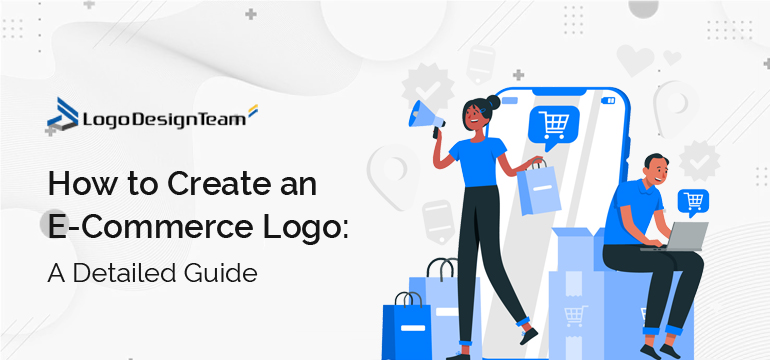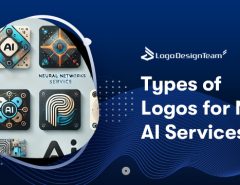A logo plays a significant role in brand recognition. Customers often remember a brand because of its logo. The logo creates lasting memories in the mind of customers. Every major company has a unique logo through which people recognize it.
When you are creating a logo for your e-business, you need to pay attention to details. Focus on something that will help people remember your brand even when they are offline. This detailed guide will help you create a highly memorable e-commerce logo.
Why a logo is important in e-commerce
The e-commerce environment is experiencing higher competition than ever. Brands are becoming more aggressive in their marketing strategies. A logo can help an e-business to build trust with its online audience. trust in e-commerce is what helps retain customers and attract a new line of customers. The e-commerce investor should create a logo that helps customers to have more trust in the brand.
Trust goes beyond the logo and into the online security, the brand provides to customers. They should ensure they use a frontend platform that provides features that make the digital user experience better. One of the favorable platforms is Vue Storefront which offers flexibility and customization on every phase of your business.
The platform provides fully customizable default themes for your Storefront UI that you can adjust to fit your brand needs. The platform can be used on multiple devices like a smartphone, laptops, desktops, and tablets. The single app provides all your e-commerce frontend needs.
A logo is important in brand recognition. Your audience should easily recognize your brand whenever they come across your logo on various online platforms. It doesn’t matter whether they are on social media, blogs, video streaming platforms, or marketing platforms.
The moment they see the logo, they should remember your brand and the products you sell. First impressions are important. Your brand logo should create long-lasting first impressions to your online audiences. This is one of the ways for turning online visitors into customers.
Types of logos
There are various different types of logos. A textual logo is typography-based. Busi-nesses may use their full business name or initials that represent it. A graphical logo can incorporate a symbol, character or other abstract elements. For example, a lion is a common symbol of strength, power, courage, and nobility. A character-based logo may use a famous person with whom people connect. Abstract logos involve using geomet-ric shapes instead of images. When an e-commerce brand expands internationally, this is the type of logo that works best. Most brands use a combination logo that includes both text and an image.
Steps for creating a logo for your e-commerce
Get logo ideas
Start by looking for ideas for creating the best logo. You may get challenges, but there are different approaches you can use. Start by brainstorming on what a unique logo would look like. Write down the ideas as they come. Another approach is to research online for ideas.
Search through multiple websites and write every idea that you get from them. You may also choose to use a logo generator to generate ideas. After you have gathered enough ideas, use the elimination method to choose the best idea and drop out the rest.
Consider your online audience
Your online audience should be the primary focus when you are creating an e-commerce logo. Your e-business might be targeting a specific audience. Your audience might be women, men, teenagers, moms, business people, or students. It all depends on the products you are selling and the customers you are targeting. Your online audience will determine the colors that you choose, symbols, fonts, or icons. A log with brighter colors can go well with teens and women.
Do not copy your competitors
Competitors scramble for the same market. They sell products that provide similar solu-tions. Regardless, you cannot create products that are the same as your competitors in terms of name, packaging, and colors.
The ingredients might be the same, but the packaging and name must be different. In the same way, your logo should be unique. Search to see what features your competitor logos have but do not use the same features. Let your logo give you a special brand identity.
Get a unique name for your e-commerce
Get a name that can be associated with your products. The name must be easy to re-member. Register the name with the registrar’s office to block away anyone else who might want to use it. The name should be available when creating your domain name. Let it be a name that is easy to remember.
Create a logo that flawlessly fits into the name
Most giant companies use their corporate name as their logo. You may choose the same approach if your name is not long. You may also decide to use its initials. Choose a symbol or icon.
Decide your logo colors and fonts
Your logo color can be the same as your e-commerce brand name colors. Remember that the colors must be attractive to your online audiences. You may want to research and understand the role colors play in different audiences, gender, and ages. Some fonts might not work to your advantage.
You must be sensitive to the fonts, symbols, and icons that you choose. Shape them in a way that your audience will love the logo. When choosing colors, do not let your logo have too many colors. A maximum of two colors are enough. Too many fonts will not work for you too. Choose a maximum of two fonts. A single font would do even better.
Edit your logo
Recheck your e-commerce logo to see if anything is missing. Focus on your audience and ask yourself how they will view the logo. It must give your online audience a long-lasting first impression. They must love it and remember it with ease.
If the logo is not meeting these qualities, edit it until it perfectly fits them. You may change the colors, fonts, shape of the symbols, or position. If you are comfortable with the logo, publish it on your e-commerce website and aggressively market your e-business.
Key things to remember
It should be adaptable: Today, a logo has to be adaptable for use in many different situations. It appears in so many places such as on your website, packaging, social media pages etc. This means you need to use both large-scale and small-scale versions that are still recognizable. From the tiny favicon in the browser to a large advert, it should retain its simplicity and detail.
In the same way, commerce platforms can no longer afford to be monolithic one-for-all solutions. They need flexibility and customization options to handle many touchpoints and reach customers where they are. Vue Storefront, the market-proven frontend plat-form will boost your site performance. It offers performance-oriented architecture, limit-less customization possibilities and a flawless user experience. The modular, API-first frontend is driven by headless technology principles, which means it gives your brand the tools to rapidly change your technology stack, operations and growth based on your business requirements.
Make your logo simple: You could be tempted to create a complicated logo. The more it gets complicated, the lesser your online audience will remember it. Focus on creating the simplest e-business logo that your audience can easily remember. A simple logo often works better than a complex one. It will convey a message your audience will trust. A complex design where they struggle to decipher what you’re trying to convey will irritate them. Minimalist designs exclude any elements that aren’t really necessary.
Let it grab attention: Competition is higher in e-commerce. Your logo must help you get the attention of your online audience. It will grab their attention if they can identify with it.
It must be attractive: Create a logo that looks attractive to everyone who comes across it when browsing online. The attractiveness of a logo is mainly determined by its shape and colors. Design the best shape and be keen on color choices.
Let it be unique: To be unique means the logo stands out from the crowd. Even if it is placed in the middle of thousands of other logos, it will be easy to pick it out due to its uniqueness. You need to think about ways to make your logo original, so it will be memorable and evoke positive emotions. It has to make a lasting first impression. People will see your logo all the time in many different places, and the more they see it, the more it resides in their brains so that they start to recognize it and make positive associations with it.
Conclusion
A brand logo becomes a symbol of your company and products that people remember and recognize. Developing a logo that works for your e-commerce business requires taking many different factors into account. A well-designed logo is a combination of visual elements and text that facilitate brand recognition. One look at it should be enough for viewers to make positive associations with it. Trust and recognition are the main reasons why your e-commerce business needs a logo.




